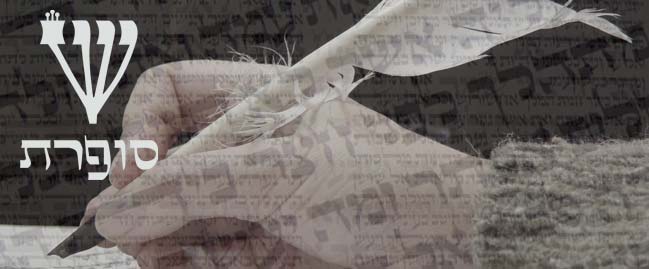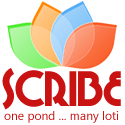MIRIYAM BENAYAHU!
BS"D
Some compelling research I have recently performed lead me to this exciting information. Wouldn't it be for the great benefit of all Jews to establish that there once existed a small soferet tradition? Halakhah depends so much on precedent, & so many rules are made to justify accepted community practices, that it would be such a treasure to be able to prove this was the case for sofrot! If anyone else out there has further information, or can put me in touch with a women's historian, please e-mail me! This just might be what we need to make women normative ritual scribes in Judaism!
Written Out of History: Our Jewish Foremothers – Sondra Henry & Emily Taitz
1983 Second Edition, Revised Biblio Press
P114
“It was rare to find a footnote such as this one by an anonymous woman:
‘I beseech the reader not to judge me harshly when he finds that mistakes have crept into this work; for when I was engaged in copying it, God blessed me with a son, and thus I could not attend to my business properly.’”*
P115
“…It was not common for women to be taught how to write at all in medieval Europe or the near East, but, as always, there were notable exceptions. Miriam Benayahu was perhaps one of the most notable. In San’ya, Yemen, where her family lived, women were generally excluded from all religious learning. Yet Miriam, a scribe of renown, copied the Torah – the Five Books of Moses, and with it a note in her own hand, which reads:
‘Do not condemn me for any errors that you may find for I am a nursing woman. Miriam, the daughter of Benayahu the Scribe’**
Miriam’s family was famous during the fourteenth century and afterwards for producing over four hundred books for synagogues and private individuals. These books are still known and remembered for their beauty and accuracy.”
* Solomom Schechter, Studies in Judaism, First series, 1911, “Women in Temple and Synagogue,” Chap. Xiii, p.264
** S.D. Gitein, Jews and Arabs: Their contact Through the Ages, (New York, Schocken Books, 3rd. ed., 1974), p. 186. See also: Encyclopaedia Judaica, “Benayah,” Vol. 4, and Jacob Saphir, Ma-asei le-Teman, (ed., A. Yaari, 1951), pp. 173-174. Saphir visited Yemen in 1859 and describes the Pentateuch that Miriam copied.
“And All Your Children Shall Be Learned” Women and the Study of Torah in Jewish Law and History – Shoshana Pantel Zolty
1993 Jason Aaronson
P 145
“When I speak of women scribes, I am not referring to a scribe in the sense of the halakhically defined “sofer”, a professional expert in the writing of Torah scrolls, tefillin, and mezuzot used for religious ritual. Rather I mean women who copied religious texts for use by the general community in the days before the advent of the printing press, when every Jewish book had to be transcribed by hand…A Pentateuch of the Late Middle Ages, discovered in Yemen and written in precise and beautiful style, is inscribed with the following inscription, ‘Please do not fault me if you find herein a mistake, as I am a nursing woman, Miriam the daughter of Benayah the Scribe.’*
At first, it seems surprising that this manuscript was found in Yemen, considering that women in Yemen were, by and large, illiterate.** Noting, however, that Miriam’s father was a scribe, one can understand how she was more likely to be literate as well as educated. If she happened to have been an only child, it would explain her level of education, since it was common practice among Yemenites who had no son to instruct a daughter…in higher Jewish subjects, even including the laws and practice of ritual slaughtering.** * There is also indirect mention of another female scribe in the Genizah documents: we are told that the Jewish community of Daquq (today called Tawuq), Iraq, was headed by Azarya, ‘son of the female copyist.’ He was praised by the Hebrew poet Judah al-Harizi for his noble descent and character as well as his munificence.”****
* Goitein, Sidrei Hinukh, p. 64
** Aharon Ben-Dod, Ha-Hinukh ha-Yehudi be-Tz’fon Taimon, p.73
*** Goitein, Jews and Arabs: Their Contact Through the Ages, p. 186.
**** Goitein, A Mediterranean Society, vol. 2, p.184
Also: Safra Benayah ben Sa'adiah
BENAYAH (Benaiah), family of scribes, who lived in Sana, Yemen, in the 15th century. The books copied by members of the family, particularly the Scriptures, are noted for accuracy and beauty, and to this day Yemenite Jews remember BENAYAH as the greatest scribe in their history. The members of the family known to have been scribes are Benayah, his sons DAVID and JOSEPH, and his daughter MIRIAM. Benayah's signature was "Safra (writer) Benayah b. Sa'adiah b. Zechariah."
According to Yemenite Jewish tradition, the Benayah family copied some 400 books for synagogues and private individuals, some of which are still extant. Most of them are unilingual Pentateuchs (Tijan), which include the large and small masorah in the margins and Mahberet al-Tijan, which deals with matters affecting the traditional reading of the scriptural text and with grammar. Apart from Pentateuchs, they also copied books of haftarot with Aramaic translations and prayer books; one such prayer book, containing a wealth of songs and piyyutim, which had been copied by Joseph, is in the Royal Library in Berlin (Heb. Ms. 103).
The periods during which members of the family engaged in their work can be determined from the dates given by the inscriptions in the books: Benayah, 1470; David, 1484–1510; and Joseph, 1485–1508. Miriam, Benayah's daughter, was a phenomenon in Yemenite society and culture, where, as a rule, women were illiterate. Jacob Saphir, who visited Yemen in 1859, describes a Pentateuch that Miriam copied, and which contains an apology by her at the end: "Do not condemn me for any errors that you may find, for I am a nursing woman; Miriam, the daughter of Benayah the scribe."
Two other scribes by the name of Benayah are known: BENAYAH B. KALEV B. MAHPUZ AL-BAULI, around 1342 (J. L. Nahum, Mi-Zefunot Yehudei Teiman (1962), 252); and BENAYAH B. SAIDA B. JOSEPH, around 1587 (Moscow, Guenzburg Ms. 1306).
by Yehuda Ratzaby
& here is a book scribed by Miriyam's brother!














0 Comments:
Post a Comment
<< Home